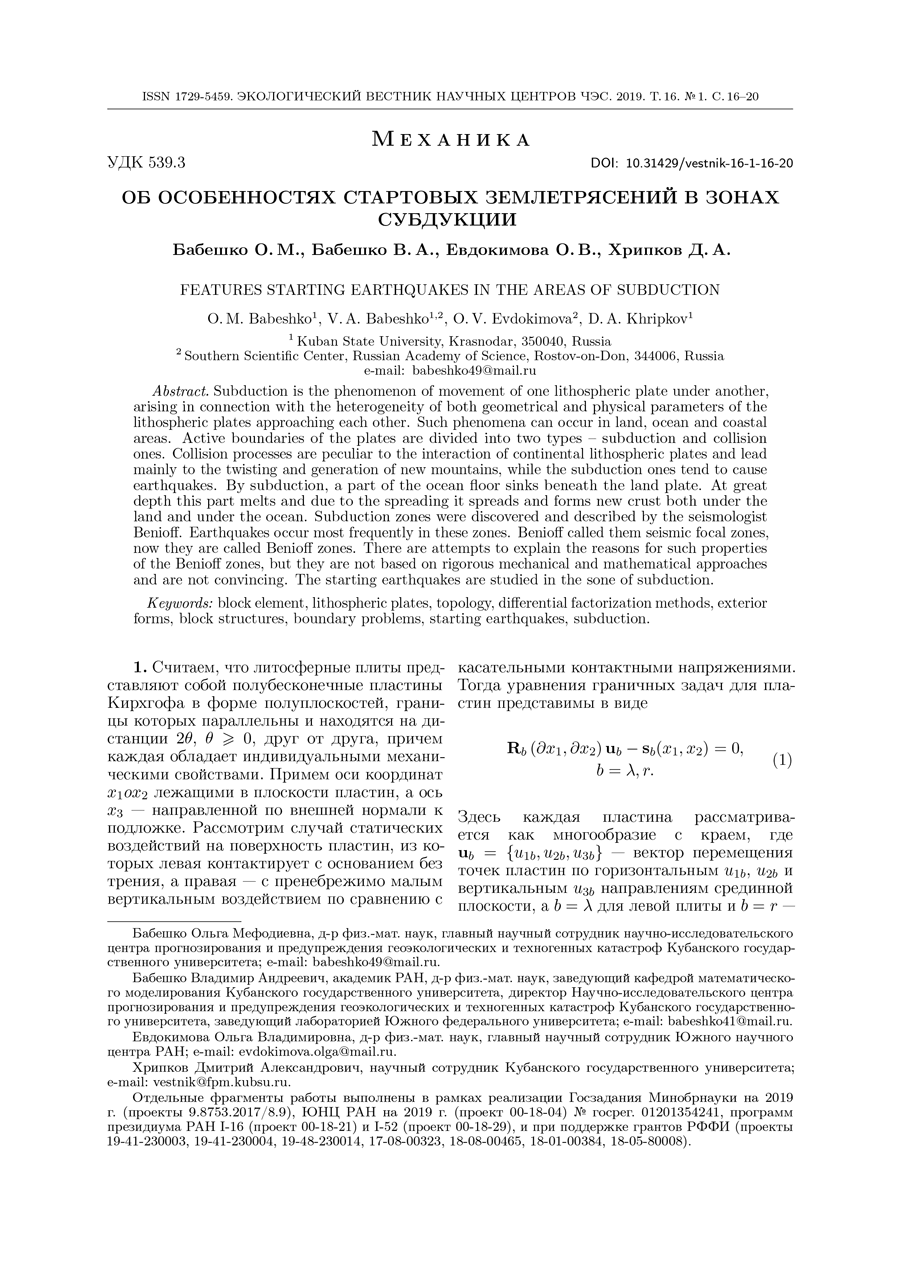Features starting earthquakes in the areas of subduction
UDC
539.3DOI:
https://doi.org/10.31429/vestnik-16-1-16-20Abstract
Subduction is the phenomenon of movement of one lithospheric plate under another, arising in connection with the heterogeneity of both geometrical and physical parameters of the lithospheric plates approaching each other. Such phenomena can occur in land, ocean and coastal areas. Active boundaries of the plates are divided into two types – subduction and collision ones. Collision processes are peculiar to the interaction of continental lithospheric plates and lead mainly to the twisting and generation of new mountains, while the subduction ones tend to cause earthquakes. By subduction, a part of the ocean floor sinks beneath the land plate. At great depth this part melts and due to the spreading it spreads and forms new crust both under the land and under the ocean. Subduction zones were discovered and described by the seismologist Benioff. Earthquakes occur most frequently in these zones. Benioff called them seismic focal zones, now they are called Benioff zones. There are attempts to explain the reasons for such properties of the Benioff zones, but they are not based on rigorous mechanical and mathematical approaches and are not convincing. The starting earthquakes are studied in the sone of subduction.
Keywords:
block element, lithospheric plates, topology, differential factorization methods, exterior forms, block structures, boundary problems, starting earthquakes, subductionAcknowledgement
References
- Babeshko V.A., Evdokimova O.V., Babeshko O.M. On the possibility of predicting some types of earthquake by a mechanical approach. Acta Mechanica, 2018, vol. 229, iss. 5, pp. 2163–2175. DOI: 10.1007/s00707-017-2092-0
- Babeshko V.A., Evdokimova O.V., Babeshko O.M. O startovykh zemletryaseniyakh pri gorizontal'nykh vozdeystviyakh [Of starting earthquakes with horizontal effects]. Doklady Akademii nauk [Rep. of the Russian Academy of Science], 2017, vol. 474, no. 4, pp. 427–431. (In Russian)
- Vorovich I.I., Babeshko V.A. Dinamicheskie smeshannye zadachi teorii uprugosti dlya neklassicheskikh oblastey [Dynamic mixed problems of elasticity theory for non-classical domains]. Nauka, Moscow, 1979. (In Russian)
- Babeshko V.A., Glushkov E.V., Zinchenko Zh.F. Dinamika neodnorodnykh lineyno-uprugikh sred [Dynamics of inhomogeneous linear-elastic media]. Nauka, Moscow, 1989. (In Russian)
- Babeshko V.A., Evdokimova O.V., Babeshko O.M. On a mechanical approach to the prediction of earthquakes during horizontal motion of litospheric plates. Acta Mechanica, 2018, vol. 229, iss. 11, pp. 4727–4739. DOI: 10.1007/s00707-018-2255-7
- Morozov N.F. Matematicheskie voprosy teorii treshchin [Mathematical problems of crack theory]. Nauka, Moscow, 1984. (In Russian)
- Nikonov A.A. Sovremennye dvizheniya Zemnoy kory [Modern movements of the Earth's crust]. Nauka, Moscow, 1979. (In Russian)
- Chernov Yu.K. Sil'nye dvizheniya grunta i kolichestvennaya otsenka seysmicheskoy opasnosti territorii [Strong ground movements and quantitative assessment of seismic hazard of the territory]. FAN, Tashkent, 1989. (In Russian)
- Rays Dzh. Mekhanika ochaga zemletryaseniya [The mechanics of the earthquake source]. Mir, Moscow, 1982. (In Russian)
- Gamburtsev G.A. Perspektivnyy plan issledovaniy po probleme "Izyskanie i razvitie prognoza zemletryaseniy". In: Razvitie idey G.A. Gamburtseva v geofizike. Nauka, Moscow, 1982, pp. 304–311. (In Russian)
Downloads
Submitted
Published
How to Cite
Copyright (c) 2019 Babeshko O.M., Babeshko V.A., Evdokimova O.V., Khripkov D.A.

This work is licensed under a Creative Commons Attribution 4.0 International License.




